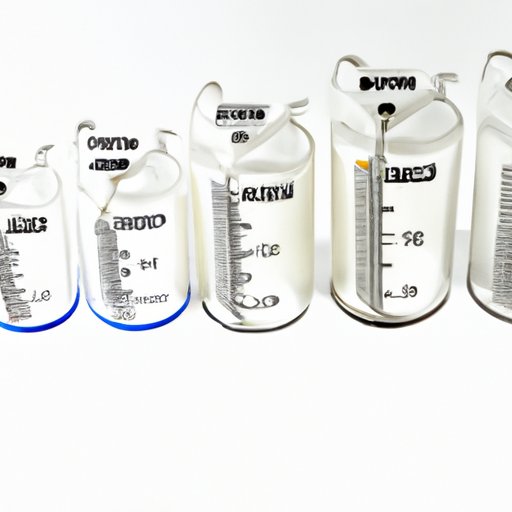Introduction
Are you tired of trying to convert pounds to liters and still not understanding the conversion? You’re not alone! Many people struggle with this conversion, but understanding it is essential for everyday life. In this article, we’ll explore how to convert pounds to liters, the science behind the conversion, and why it matters in daily life.
How to Convert Pounds to Liters: A Simple Guide
Converting pounds to liters may seem complex, but it is simple if you follow the right steps. Here’s what you need to do:
1. Determine the density of the substance you’re measuring: The density is the amount of mass per unit of volume, usually measured in grams per milliliter. You can find the density of most substances online or by checking the packaging.
2. Multiply the number of pounds by 0.453592 to convert to kilograms: Kilograms are the standard unit of mass in the metric system, which is used for liters. For example, if you have 5 pounds of flour, multiply 5 by 0.453592 to get 2.26796 kilograms.
3. Divide the number of kilograms by the density of the substance: This will give you the volume in liters. For example, if the density of your flour is 0.56 grams per milliliter, divide 2.26796 by 0.56 to get 4.04993 liters.
The Science Behind Converting Pounds to Liters
To understand how to convert pounds to liters, you need to know the relationship between mass and volume. Mass is the amount of matter in an object, while volume is the amount of space it takes up. Different units of measurement are used to measure mass and volume. Pounds are used to measure mass, while liters are used to measure volume.
The conversion from pounds to liters involves understanding the density of the substance being measured. Density is a measure of how much mass is packed into a unit of volume. It is usually measured in grams per milliliter. The denser a substance is, the more mass it has for a given volume, and the less space it takes up.
A Complete Overview of How Many Liters are in a Pound
The number of liters in a pound depends on the density of the substance being measured. Here are some common conversions:
– One pound of water = 0.45 liters
– One pound of flour = 0.81 liters
– One pound of sugar = 0.49 liters
– One pound of milk = 0.47 liters
To convert pounds to liters accurately, you need to use the correct conversion factor, depending on the density of the substance.
From Ounces to Liters: Understanding the Conversion Factor of Pounds
Pounds are a unit of measurement commonly used for mass in the United States. To convert smaller units of mass, such as ounces, to pounds, you need to understand the conversion factor. There are 16 ounces in a pound, so to convert ounces to pounds, divide the number of ounces by 16. For example, 24 ounces would be 24/16 = 1.5 pounds.
Understanding the conversion factor is essential because it allows you to convert between different units of measurement accurately.
Common Uses of Pounds and Liters – And How to Convert Them
Pounds and liters are commonly used as measurements in everyday life. Here are some examples:
– Cooking and baking: Recipes often use pounds, ounces, and liters to measure ingredients. It’s essential to convert accurately to avoid ruining the recipe.
– DIY projects: Paint, cement, and other materials for DIY projects are often sold in pounds or liters. Using the correct amount is essential for the project’s success and ensuring you have enough materials.
– Fuel efficiency: Fuel efficiency is often measured in liters per kilometer or gallons per mile. Understanding the conversion between liters and gallons is essential for comparing fuel efficiency.
To convert pounds and liters accurately in these situations, you need to understand the conversion factor and use it correctly.
Why Converting Pounds to Liters Matters in Daily Life
It’s essential to convert pounds to liters accurately because incorrect conversions can impact recipes, DIY projects, and more. Adding too much or too little of an ingredient can ruin a recipe or impact the final product’s quality. Using too little or too much of a material in DIY projects can impact the project’s success or result in damage or injury.
Inaccurate conversions can also impact fuel efficiency, resulting in inaccurate comparisons and decisions.
Conclusion
Converting pounds to liters is essential for everyday life’s accuracy and success, whether you’re cooking, doing DIY projects, or comparing fuel efficiency. Understanding the conversion factor and density of the substance being measured is essential for accurate conversions. By following the steps outlined in this article, you can confidently convert pounds to liters and use them accurately in any situation.
